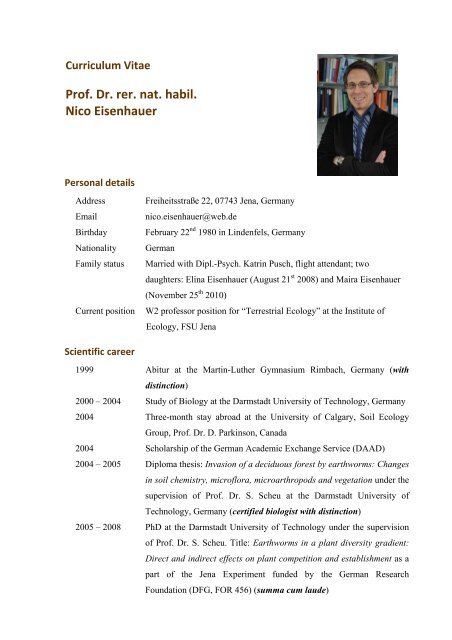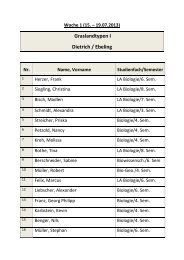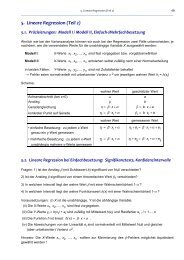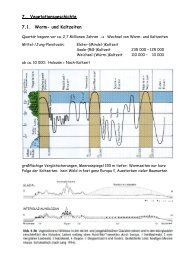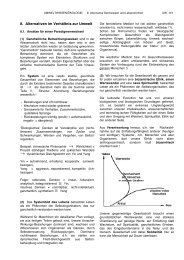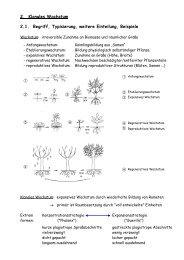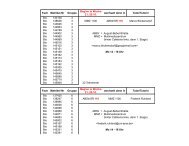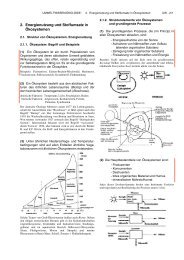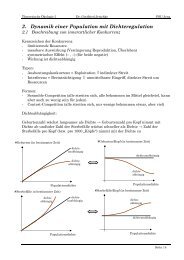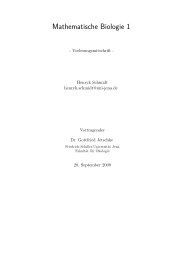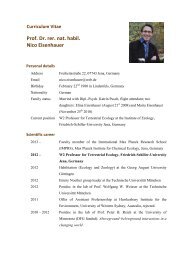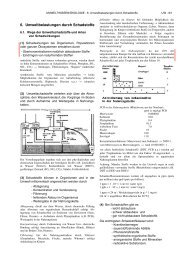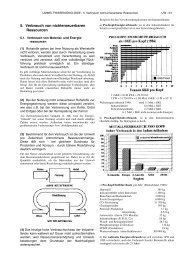Prof. Dr. rer. nat. habil. Nico Eisenhauer - Institut für Ãkologie
Prof. Dr. rer. nat. habil. Nico Eisenhauer - Institut für Ãkologie
Prof. Dr. rer. nat. habil. Nico Eisenhauer - Institut für Ãkologie
You also want an ePaper? Increase the reach of your titles
YUMPU automatically turns print PDFs into web optimized ePapers that Google loves.
Curriculum Vitae<br />
<strong>Prof</strong>. <strong>Dr</strong>. <strong>rer</strong>. <strong>nat</strong>. <strong>habil</strong>.<br />
<strong>Nico</strong> <strong>Eisenhauer</strong><br />
Personal details<br />
Address<br />
Email<br />
Birthday<br />
Nationality<br />
Family status<br />
Current position<br />
Freiheitsstraße 22, 07743 Jena, Germany<br />
nico.eisenhauer@web.de<br />
February 22 nd 1980 in Lindenfels, Germany<br />
German<br />
Married with Dipl.-Psych. Katrin Pusch, flight attendant; two<br />
daughters: Elina <strong>Eisenhauer</strong> (August 21 st 2008) and Maira <strong>Eisenhauer</strong><br />
(November 25 th 2010)<br />
W2 professor position for “Terrestrial Ecology” at the <strong>Institut</strong>e of<br />
Ecology, FSU Jena<br />
Scientific career<br />
1999 Abitur at the Martin-Luther Gymnasium Rimbach, Germany (with<br />
distinction)<br />
2000 – 2004 Study of Biology at the Darmstadt University of Technology, Germany<br />
2004 Three-month stay abroad at the University of Calgary, Soil Ecology<br />
Group, <strong>Prof</strong>. <strong>Dr</strong>. D. Parkinson, Canada<br />
2004 Scholarship of the German Academic Exchange Service (DAAD)<br />
2004 – 2005 Diploma thesis: Invasion of a deciduous forest by earthworms: Changes<br />
in soil chemistry, microflora, microarthropods and vegetation under the<br />
supervision of <strong>Prof</strong>. <strong>Dr</strong>. S. Scheu at the Darmstadt University of<br />
Technology, Germany (certified biologist with distinction)<br />
2005 – 2008 PhD at the Darmstadt University of Technology under the supervision<br />
of <strong>Prof</strong>. <strong>Dr</strong>. S. Scheu. Title: Earthworms in a plant diversity gradient:<br />
Direct and indirect effects on plant competition and establishment as a<br />
part of the Jena ExperimentH funded by the German Research<br />
Foundation (DFG, FOR 456) (summa cum laude)
2008 – 2010 Post-Doc in the Jena Experiment. Subproject Decomposer Interaction<br />
Webs<br />
2010 – 2012 Post-Doc in the lab of <strong>Prof</strong>. Peter B. Reich at the University of<br />
Minnesota (DFG funded; Ei 862/1-1): Aboveground–belowground<br />
interactions in a changing world<br />
2012 Post-Doc in the lab of <strong>Prof</strong>. Wolfgang W. Weisser at the Technische<br />
Universität München<br />
2012 Emmy Noether group leader at the Technische Universität München<br />
2012 Habilitation (Ecology and Zoology) at the Georg August University<br />
Göttingen<br />
2012 – W2 professorship “Terrestrial Ecology”, Friedrich-Schiller-University<br />
Jena, Germany<br />
Teaching experience<br />
2003 – 2005 Tutor of six practical courses at the Darmstadt University of<br />
Technology (Botany: Struktur und Funktion von Organismen), 3 SWS<br />
These practicals had a strong focus on the morphology of plants.<br />
Morphological details were related to functional characteristics and the<br />
ecology of the organisms.<br />
2003 - 2005 Tutor of two practical courses at the Darmstadt University of<br />
Technology (Zoology: Biodiversität und Phylogenie), 3 SWS<br />
These practicals had a strong focus on the morphology of animals.<br />
Morphological details were related to functional characteristics and the<br />
ecology of the organisms.<br />
2004 – 2009 Leader of fourteen zoological expeditions at the Darmstadt University<br />
of Technology and at the University of Göttingen<br />
These expeditions focussed on the biodiversity of above- and<br />
belowground invertebrates in different and contrasting habitats (nutrient<br />
poor versus fertilized grasslands, different forest types etc.). Students<br />
learned to utilize plants and animals as indicator species for habitat<br />
characteristics and adaptations of organisms to different environmental<br />
conditions.<br />
2006 – Supervisor of six Teacher’s theses, five Bachelor thesis, three Diploma<br />
theses, two Master’s theses, and several research practicals; currently<br />
supervisor of three PhDs
See below for more information.<br />
2008, 2012 Guest lectures on Split-plot analysis<br />
A lot of ecological experiments should be analyzed using split-plot<br />
analysis due to the non-independence of treatments. This problem<br />
applies to many field studies with nested designs, but also to<br />
greenhouse, chamber and lab experiments. Students learn how common<br />
split-plot experiments are and how to statistically analyze such<br />
experiments.<br />
2012 Lecture/Project Biodiversität at the Technische Universität München,<br />
Studienfakultät Forstwissenschaft und Ressourcenmanagement, 4 SWS<br />
This hybrid course introduces anthropogenic global change agents as<br />
well as their causes and consequences. One focus is anthropogenic N<br />
deposition and the effects on the functioning and biodiversity of<br />
ecosystems. After learning the theoretical background (lecture),<br />
students have to develop a research plan how to investigate the effect of<br />
N fertilization on forest stands directly bordering to agricultural fields.<br />
The students learn how to design and analyze ecological experiments,<br />
methods related to the assessment of plant community structure, soil<br />
microorganisms and soil meso- and macroarthropods, as well as how to<br />
write a scientific article.<br />
2012 Terrestrial Practical (basic practical) at the Technische Universität<br />
München, 4 SWS<br />
The practical introduces the wealth of methods in terrestrial ecology for<br />
sampling / assessing organisms above and below the ground.<br />
2012 Research Practical in Terrestrial Ecology at the Technische Universität<br />
München, 16 SWS<br />
In the frame of an interesting research project the students learn<br />
different methods of sampling and analyzing soil microorganisms and<br />
soil fauna. Depending on the topic of the practical they learn how to<br />
identify soil microarthropods or how to measure the respiration,<br />
biomass, carbon use efficiency and nutrient limitations of soil<br />
microorganisms. Finally, they learn how to statistically analyze their<br />
data and how to write a scientific article.<br />
2012 Methods in Field Ecology at the FSU Jena
Students learn different methods in field ecology in a practical, such as<br />
the sampling and extraction of soil organisms.<br />
2012 <strong>Institut</strong>e Seminar at the FSU Jena<br />
Organization of a series of talks on research of PhD and Master<br />
students.<br />
2012 Advanced Ecological Seminar at the FSU Jena<br />
Discussion of recent and classic papers in ecology. Students have to<br />
prepare a topic and use several papers to discuss recent developments in<br />
ecological research.<br />
Editorial board<br />
2011 – Biodiversity and Conservation<br />
2012 – Plant and Soil<br />
Reviewer for scientific journals<br />
Applied Soil Ecology, Basic and Applied Ecology, Catena, Diversity, Ecology, Ecography,<br />
Ecology Letters, Écoscience, European Journal of Soil Biology, Global Ecology and<br />
Biogeography, ISME Journal, Journal of Applied Ecology, Journal of Ecology, Journal of<br />
Vegetation Science, Nature Climate Change, Oecologia, Oikos, Pedobiologia, Plant<br />
Biology, Plant and Soil, PLoS ONE, Philosophical Transactions of the Royal Society B,<br />
Soil Biology and Biochemistry; Reviewer of >80 papers and research proposals<br />
Reviewer for foundations<br />
Czech Science Foundation, German Research Foundation, Helmholtz Impulse Fond, Swiss<br />
National Science Foundation<br />
Memberships<br />
Ecological Society of America (ESA), Ecological Society of Germany, Austria and<br />
Switzerland (GfÖ)<br />
Grants<br />
2004 Scholarship by the German Academic Exchange Foundation (~3,000 €)<br />
2010 PI in the Jena Experiment (with <strong>Prof</strong>. <strong>Dr</strong>. Stefan Scheu), SP4: Plant –<br />
soil fauna interactions, funded by the German Research Foundation<br />
(~280,000 €)
2010 Post-Doc Scholarship by the German Research Foundation, Ei 862/1<br />
(~100,000 €)<br />
2011 Co-PI (with <strong>Dr</strong>. Olaf Butenschoen) in A biodiversity approach to<br />
improve bioremediation strategies for PAH contami<strong>nat</strong>ed soils, funded<br />
by the Federal Ministry of Education and Research, Germany (21,312<br />
€)<br />
2011 Co-PI (with <strong>Dr</strong>. Alexandre Jousset) in The role of plant diversity for the<br />
promotion of bacterial communities responsible for soil<br />
suppressiveness against phytopathogens (JO 935/2), funded by the<br />
German Research Foundation (168,600 €).<br />
2011 German Academic Exchange Foundation, Travel expenses for the<br />
Annual Meeting of the Ecological Society of America in Austin, TX,<br />
USA (~800 €)<br />
2011 Department of Energy, USA, Climate change impacts at the temperateboreal<br />
ecotone: interactions between warming and precipitation, (~<br />
US$ 2,500,000; with <strong>Prof</strong>. P.B. Reich, <strong>Prof</strong>. <strong>Dr</strong>. S. Hobbie, <strong>Prof</strong>. <strong>Dr</strong>. R.<br />
Montgomery, <strong>Dr</strong>. R. Rich)<br />
2011 National Science Foundation, USA, The complexity of global changeinteractive<br />
effects of warming, water availability, CO 2 and N on<br />
grassland ecosystem function (US$ 950,839; with <strong>Prof</strong>. P.B. Reich,<br />
<strong>Prof</strong>. <strong>Dr</strong>. S. Hobbie, <strong>Prof</strong>. <strong>Dr</strong>. R. Montgomery, <strong>Dr</strong>. R. Rich)<br />
2012 Emmy Noether group funded by the German Science Foundation, Ei<br />
862/2, Aboveground–belowground interactionsdrive the relationship<br />
between plant diversity and ecosystem function (877,440 €; for 5 years,<br />
3 PhDs)<br />
Supervised theses<br />
PhD theses<br />
2010 – Britta Merkel: Plant – soil fauna interactions in a plant diversity<br />
gradient: plant diversity effects on soil biota and soil feedbacks to<br />
plants (Georg-August-Universität Göttingen, with <strong>Prof</strong>. <strong>Dr</strong>. S. Scheu)<br />
2010 – Tanja Strecker: Plant – soil fauna interactions in a plant diversity<br />
gradient: the functional composition of soil food webs (Georg-August-<br />
Universität Göttingen, with <strong>Prof</strong>. <strong>Dr</strong>. S. Scheu)
2011 – Ellen Latz: Effect of plant diversity on soil bacterial communities<br />
responsible for soil suppressiveness against phytopathogens (Georg-<br />
August-Universität Göttingen, with <strong>Dr</strong>. A. Jousset)<br />
2012 – Madhav Thakur: Does global change intensify plant diversity effects on<br />
soil biota and subsequent feedback effects? (FSU Jena)<br />
2012 – Christoph Dietrich: Tree diversity effects on soil biota and soil feedback<br />
effects (FSU Jena)<br />
Diploma theses, bachelor theses, research practicals<br />
2006 – 2007 Martin Schuy: Direkte und indirekte Wirkung von Regenwürmern auf<br />
die Keimung von Pflanzensamen<br />
2006 – 2008 Volker Hörsch: Wechselwirkungen zwischen Zersetzern (Lumbricidae:<br />
Aporrectodea caliginosa und Lumbricus terrestris) und<br />
phytopathogenen Pilzen (Fusarium graminearum): Einfluss auf das<br />
Wachstum und den Befall von Weizen (Triticum aestivum) durch<br />
Pflanzenfresser (Rhopalosiphum padi)<br />
2007 Daniela Straube: Efficiency of two widespread non-destructive<br />
extraction methods under dry soil conditions for different ecological<br />
earthworm groups<br />
2007 Christiane Schmidt: Einfluss von funktionellen Pflanzengruppen und<br />
ausgesäter Diversität, sowie Insektizidapplikation auf die<br />
Myriapodagruppen Chilopoda und Symphyla<br />
2007 – 2008 Daniela Straube: Nonlinearity of effects of invasive ecosystem engineers<br />
on abiotic soil properties and soil biota<br />
2008 Svenja Gass: Einfluss von Pflanzendiversität und funktioneller Identität<br />
auf Nematodengemeinschaften<br />
2008 Felix Schonert: Einfluss von Pflanzendiversität auf die Bodenfauna<br />
einer experimentell angelegten Graslandgemeinschaft (awarded by the<br />
state of Hesse: „Best teachers‘ thesis in 2008“)<br />
2008 Matthias Klier: Nematoden in einem Pflanzendiversitätsgradienten:<br />
Einfluss auf Mikroorganismen und Pflanzenwachstum<br />
2009 Stefan Radsick: Haben Regenwürmer nährstoffreiche<br />
Nahrungsquellen? Der Fraß an Pflanzensamen und Keimlingen
2009 Johanna Brenner: Einfluss von Pflanzendiversität auf Abundanzen,<br />
Diversität und zeitliche Stabilität der Bodenmakrofauna einer<br />
experimentell angelegten Graslandgesellschaft<br />
2009 – 2010 Ellen Latz: Correlation between plant diversity and soil<br />
suppressiveness<br />
2009 – 2010 Florian Andreas Schwarzmüller: Dynamic stability and interaction<br />
strengths in soil food-web motifs<br />
2010 Karolin Thomisch: Struktur des Bodennahrungsnetzes in einem<br />
Pflanzendiversitätsgradienten<br />
2010 Wiebke Schulz: Influence of biodiversity and resource complexity on<br />
the invasibility of bacterial communities<br />
2012 Katja Steinauer: Effects of N deposition on soil organisms and functions<br />
in two deciduous forests<br />
2012 Yasemin Günay: Transgressive overyielding of soil microbial biomass<br />
in a grassland plant diversity gradient<br />
2012 Anne Klama: Effects of elevated temperature and altered precipitation<br />
regimes on soil food web structure<br />
2012 Katja Steinauer: Interactive effects of warming and plant diversity on<br />
soil microbial community structure and functions<br />
2012 Josephine Grenzer: Collembola identity and diversity effects on soil<br />
microbial communities and ecosystem multifunctionality<br />
Papers in peer‐reviewed journals (chronologically, date of acceptance)<br />
57 Allan E, Weisser WW, Fischer M, Schulze E-D, Weigelt A, Roscher C, Baade J,<br />
Barnard RL, Beßler H, Buchmann N, Ebeling A, <strong>Eisenhauer</strong> N, Engels C, Fergus AJF,<br />
Gleixner G, Gubsch M, Halle S, Klein AM, Kertscher I, Kuu A, Lange M, Le Roux X,<br />
Meyer S, Migunova VD, Milcu A, Niklaus PA, Oelmann Y, Pašalić E, Petermann JS,<br />
Poly F, Rottstock T, Sabais ACW, Scherber C, Sche<strong>rer</strong>-Lorenzen M, Scheu S,<br />
Steinbeiss S, Schwichtenberg G, Temperton V, Tscharntke T, Voigt W, Wilcke W,<br />
Wirth C, Schmid B (2013) A comparison of the strength of biodiversity effects across<br />
multiple functions. Oecologia, in press.<br />
56 Griffith B, Türke M, Weisser WW, <strong>Eisenhauer</strong> N (2013) Herbivore behavior in the<br />
anecic earthworm species Lumbricus terrestris L.? European Journal of Soil Biology, in<br />
press.
55 Türke M, Blattmann T, Knop E, Kindermann A, Prestele J, Marquez L, <strong>Eisenhauer</strong> N,<br />
Fischer C (2013) Weeds and endangered herbs have unforeseen dispersal helpers in the<br />
agri-environment: grastropods and earthworms. Renewable Agriculture and Food<br />
Systems, in press.<br />
54 Fisichelli NA, Frelich LE, Reich PB, <strong>Eisenhauer</strong> N (2013) Linking direct and indirect<br />
pathways mediating earthworms, deer, and understory composition in Great Lakes.<br />
Biological Invasions, in press.<br />
53 <strong>Eisenhauer</strong> N, Reich PB, Scheu S (2012) Increasing plant diversity effects on<br />
productivity with time due to delayed soil biota effects on plants. Basic and Applied<br />
Ecology 13: 571-578.<br />
52 <strong>Eisenhauer</strong> N, Schulz W, Scheu S and Jousset A (2012) Niche dimensionality links<br />
biodiversity and invasibility of microbial communities. Functional Ecology, doi:<br />
10.1111/j.1365-2435.2012.02060.x.<br />
51 Frelich LE, Peterson RO, Dovčiak M, Reich PB, Vucetich JA and <strong>Eisenhauer</strong> N (2012)<br />
Trophic cascades, invasive species, and body-size hierarchies interactively modulate<br />
climate change responses of ecotonal temperate-boreal forests. Philosophical<br />
Transactions of the Royal Society B 367: 2955-2961.<br />
50 Sabais ACW, <strong>Eisenhauer</strong> N, König S, Renker C, Buscot F and Scheu S (2012) Soil<br />
organisms shape the competition between grassland plant species. Oecologia 170:<br />
1021-1032.<br />
49 <strong>Eisenhauer</strong> N, Reich PB and Isbell F (2012) Decomposer diversity and identity<br />
influence plant diversity effects on ecosystem functioning. Ecology 93: 2227-2240.<br />
48 <strong>Eisenhauer</strong> N, Scheu S and Jousset A (2012) Bacterial diversity stabilizes community<br />
productivity. PLoS ONE 7: e.34517.<br />
47 Reich PB, Tilman D, Isbell F, Mueller K, Hobbie SE, Flynn DFB and <strong>Eisenhauer</strong> N<br />
(2012) Impacts of biodiversity loss escalate through time as redundancy fades. Science<br />
336: 589-592. Recommended by F1000.<br />
46 Becker J, <strong>Eisenhauer</strong> N, Scheu S and Jousset A (2012) Increasing antagonistic<br />
interactions cause bacterial communities to collapse at high diversity. Ecology Letters<br />
15: 468-474.<br />
45 Rosenkranz S, Wilcke W, <strong>Eisenhauer</strong> N and Oelmann Y (2012) Net ammonification as<br />
influenced by plant diversity in experimental grasslands. Soil Biology and Biochemistry<br />
48: 78-87.
44 Latz E, <strong>Eisenhauer</strong> N, Rall BC, Allan E, Roscher C, Scheu S and Jousset A (2012)<br />
Plant diversity improves protection against soil-borne pathogens by fostering<br />
antagonistic bacterial communities. Journal of Ecology 100: 597-604. Highlighted in<br />
The Scientist.<br />
43 <strong>Eisenhauer</strong> N and Reich PB (2012) Above- and belowground inputs both fuel soil food<br />
webs. Soil Biology and Biochemistry 45: 156-160.<br />
42 <strong>Eisenhauer</strong> N (2012) Aboveground-belowground interactions as a source of<br />
complementarity effects in biodiversity experiments. Plant and Soil 351: 1-22.<br />
41 <strong>Eisenhauer</strong> N, Cesarz S, Koller R, Worm K and Reich PB (2012) Global change below<br />
ground: impacts of elevated CO 2 , nitrogen and summer drought on soil food webs and<br />
biodiversity. Global Change Biology 18: 435-447.<br />
40 <strong>Eisenhauer</strong> N, Fisichelli NA, Frelich LE and Reich PB (2012) Interactive effects of<br />
global warming and ‘global worming’ on the initial establishment of <strong>nat</strong>ive and exotic<br />
herbaceous plant species. Oikos 121: 1121-1133.<br />
39 <strong>Eisenhauer</strong> N, Migunova VD, Ackermann M, Ruess L and Scheu S (2011) Changes in<br />
plant species richness induce functional shifts in soil nematode communities in<br />
experimental grassland. PLoS ONE 6: e24087.<br />
38 <strong>Eisenhauer</strong> N, Schlaghamerský J, Reich PB and Frelich LE (2011) The wave towards a<br />
new steady state: effects of earthworm invasion on soil microbial functions. Biological<br />
Invasions 13: 2191-2196.<br />
37 Butenschoen O, Scheu S and <strong>Eisenhauer</strong> N (2011) Interactive effects of warming, soil<br />
humidity and plant diversity on litter decomposition and microbial functioning. Soil<br />
Biology and Biochemistry 43: 1902-1907.<br />
36 <strong>Eisenhauer</strong> N, Sabais ACW and Scheu S (2011) Collembola species composition and<br />
diversity effects on ecosystem functioning vary with plant functional group. Soil<br />
Biology and Biochemistry 43: 1697-1704.<br />
35 Forey E, Barot S, Decaëns T, Langlois E, Laossi K-L, Margerie P, Scheu S and<br />
<strong>Eisenhauer</strong> N (2011) Importance of earthworm–seed interactions for the structure and<br />
composition of plant communities: a review. Acta Oecologica 37: 594-603.<br />
34 Jousset A, Schmid B, Scheu S and <strong>Eisenhauer</strong> N (2011) Genotypic richness and<br />
dissimilarity opposingly affect ecosystem functioning. Ecology Letters 14: 537-545.<br />
33 Sabais ACW, Scheu S and <strong>Eisenhauer</strong> N (2011) Plant species richness drives the<br />
density and diversity of Collembola in temperate grassland. Acta Oecologica 37: 195-<br />
202.
32 Jousset A, Schulz W, Scheu S and <strong>Eisenhauer</strong> N (2011) Intraspecific genotypic<br />
richness and relatedness predict the invasibility of microbial communities. ISME<br />
Journal 5: 1108-1114. Research highlight in Nature Reviews Microbiology 9: 312-<br />
313; Highlighted in The Scientist.<br />
31 <strong>Eisenhauer</strong> N, Milcu A, Allan E, Nitschke N, Scherber C, Temperton V, Weigelt A,<br />
Weisser WW and Scheu S (2011) Impact of above- and below-ground invertebrates on<br />
temporal and spatial stability of grassland of different diversity. Journal of Ecology 99:<br />
572-582.<br />
30 <strong>Eisenhauer</strong> N, Milcu A, Sabais ACW, Bessler H, Brenner J, Engels C, Klarner B,<br />
Maraun M, Partsch S, Roscher C, Schonert F, Temperton V, Thomisch K, Weigelt A,<br />
Weisser WW and Scheu S (2011) Plant diversity surpasses plant functional groups and<br />
plant productivity as driver of soil biota in the long term. PLoS ONE 6: e16055.<br />
29 <strong>Eisenhauer</strong> N, Yee K, Johnson EA, Maraun M, Parkinson D, Straube D and Scheu S<br />
(2011) Positive relationship between herbaceous layer diversity and the performance of<br />
soil biota in a temperate forest. Soil Biology and Biochemistry 43: 462-465.<br />
28 <strong>Eisenhauer</strong> N and Schädler M (2011) Inconsistent impacts of decomposer diversity on<br />
the stability of aboveground and belowground ecosystem functions. Oecologia 165:<br />
403-415.<br />
27 Proulx R, Wirth C, Voigt W, Weigelt A, Roscher C, Attinger S, Baade J, Barnard RL,<br />
Buchmann N, Buscot F, <strong>Eisenhauer</strong> N, Fischer M, Gleixner G, Halle S, Hildebrandt A,<br />
Kowalski E, Kuu A, Lange M, Milcu A, Niklaus PA, Oelmann Y, Rosenkranz S, Sabais<br />
ACW, Scherber C, Sche<strong>rer</strong>-Lorenzen M, Scheu S, Schulze E-D, Schumacher J,<br />
Schwichtenberg G, Soussana J-F, Temperton V, Weisser WW, Wilcke W and Schmid B<br />
(2010) Diversity promotes temporal stability across levels of ecosystem organization in<br />
experimental grasslands. PLoS ONE 5: e13382.<br />
26 Scherber C, <strong>Eisenhauer</strong> N, Weisser WW, Schmid B, Voigt W, Schulze E-D, Roscher<br />
C, Weigelt A, Allan E, Beßler H, Bonkowski M, Buchmann N, Buscot F, Clement LW,<br />
Ebeling A, Engels C, Fischer M, Halle S, Kertscher I, Klein A-M, Koller R, König S,<br />
Kowalski E, Kummer V, Kuu A, Lange M, Lauterbach D, Middelhoff C, Migunova<br />
VD, Milcu A, Müller R, Partsch S, Petermann JS, Renker C, Rottstock T, Sabais ACW,<br />
Scheu S, Schumacher J, Temperton VM and Tscharnke T (2010) Bottom-up effects of<br />
plant diversity on biotic interactions in a biodiversity experiment. Nature 468: 553-556.<br />
Recommended by F1000.
25 Milcu A, Thebault E, Scheu S and <strong>Eisenhauer</strong> N (2010) Plant diversity enhances the<br />
reliability of belowground processes. Soil Biology and Biochemistry 42: 2102-2110.<br />
24 <strong>Eisenhauer</strong> N, Ackermann M, Gass S, Klier M, Migunova VD, Nitschke N, Ruess L,<br />
Sabais A, Weisser WW and Scheu S (2010) Nematicide impacts on nematodes and<br />
feedbacks on plant productivity in a plant diversity gradient. Acta Oecologica 36: 477-<br />
483.<br />
23 Asshoff R, Scheu S and <strong>Eisenhauer</strong> N (2010) Different earthworm ecological groups<br />
interactively impact plant seedling establishment. European Journal of Soil Biology 46:<br />
330-334.<br />
22 <strong>Eisenhauer</strong> N (2010) The action of an animal ecosystem engineer: Identification of the<br />
main mechanisms of earthworm impacts on soil microarthropods. Pedobiologia 53:<br />
343-352.<br />
21 <strong>Eisenhauer</strong> N, Sabais A, Schonert F and Scheu S (2010) Soil arthropods beneficially<br />
rather than detrimentally impact plant performance in experimental grassland systems<br />
of different diversity. Soil Biology and Biochemistry 42: 1418-1424.<br />
20 <strong>Eisenhauer</strong> N, Butenschoen O, Radsick S and Scheu S (2010) Earthworms as seedling<br />
predators: Importance of seeds and seedlings for earthworm nutrition. Soil Biology and<br />
Biochemistry 42: 1245-1252. Highlighted in BBC News, BBC Magazine, and<br />
Spektrum der Wissenschaft.<br />
19 Scherber C, Mwangi P, Schmitz M, Sche<strong>rer</strong>-Lorenzen M, Bessler H, Engels C,<br />
<strong>Eisenhauer</strong> N, Migunova V, Scheu S, Weisser WW, Schulze E-D and Schmid B (2010)<br />
Biodiversity and belowground interactions mediate community invasion resistance<br />
against a tall herb invader. Journal of Plant Ecology 3: 99-108.<br />
18 <strong>Eisenhauer</strong> N, Bessler H, Engels C, Gleixner G, Habekost M, Milcu A, Partsch S,<br />
Sabais ACW, Scherber C, Steinbeiss S, Weigelt A, Weisser WW and Scheu S (2010)<br />
Plant diversity effects on soil microorganisms support the singular hypothesis. Ecology<br />
91: 485-496.<br />
17 <strong>Eisenhauer</strong> N, Hörsch V, Moeser J and Scheu S (2010) Synergistic effects of microbial<br />
and animal decomposers on plant and herbivore performance. Basic and Applied<br />
Ecology 11: 23-34.<br />
16 Fründ H-C, Butt K, Capowiez Y, <strong>Eisenhauer</strong> N, Emmerling C, Ernst G, Potthoff M,<br />
Schädler M and Schrader S (2010) Using earthworms as model organisms in the<br />
laborytory: Recommendations for experimental implementations. Pedobiologia 53: 119-<br />
125.
15 <strong>Eisenhauer</strong> N, Milcu A, Sabais ACW, Bessler H, Weigelt A, Engels C and Scheu S<br />
(2009) Plant community impacts on the structure of earthworm communities depend on<br />
season and change with time. Soil Biology and Biochemistry 41: 2430-2443.<br />
14 <strong>Eisenhauer</strong> N, Milcu A, Sabais ACW and Scheu S (2009) Earthworms enhance plant<br />
regrowth in a grassland plant diversity gradient. European Journal of Soil Biology 45:<br />
455-458.<br />
13 <strong>Eisenhauer</strong> N, Straube S, Johnson EA, Parkinson D and Scheu S (2009) Exotic<br />
ecosystem engineers change the emergence of plants from the seed bank of a deciduous<br />
forest. Ecosystems 12: 1008-1016.<br />
12 <strong>Eisenhauer</strong> N, Milcu A, Nitschke N, Sabais ACW, Scherber C and Scheu S (2009)<br />
Earthworm and belowground competition effects on plant productivity in a plant<br />
diversity gradient. Oecologia 161: 291-301.<br />
11 Straube D, Johnson EA, Parkinson D, Scheu S and <strong>Eisenhauer</strong> N (2009) Nonlinearity<br />
of effects of invasive ecosystem engineers on abiotic soil properties and soil biota.<br />
Oikos 118: 885-896.<br />
10 <strong>Eisenhauer</strong> N, Klier M, Partsch S, Sabais ACW, Scherber C, Weisser W and Scheu S<br />
(2009) No interactive effects of pesticides and plant diversity on soil microbial biomass<br />
and respiration. Applied Soil Ecology 42: 31-36.<br />
9 <strong>Eisenhauer</strong> N, König S, Sabais ACW, Renker C, Buscot F and Scheu S (2009) Impacts<br />
of earthworms and arbuscular mycorrhizal fungi (Glomus intraradices) on plant<br />
performance are not interrelated. Soil Biology and Biochemistry 41: 561-567.<br />
8 <strong>Eisenhauer</strong> N, Schuy M, Butenschoen O and Scheu S (2009) Direct and indirect effects<br />
of endogeic earthworms on plant seeds. Pedobiologia 52: 151-162.<br />
7 <strong>Eisenhauer</strong> N, Milcu A, Sabais ACW and Scheu S (2008) Animal ecosystem engineers<br />
modulate the diversity-invasibility relationship. PLoS ONE 3: e3489.<br />
6 <strong>Eisenhauer</strong> N and Scheu S (2008) Earthworms as drivers of the competition between<br />
grasses and legumes. Soil Biology and Biochemistry 40: 2650-2659. Recommended by<br />
F1000.<br />
5 Habekost M, <strong>Eisenhauer</strong> N, Scheu S, Steinbeiss S, Weigelt A and Gleixner G (2008)<br />
Seasonal changes in the soil microbial community in a grassland plant diversity<br />
gradient four years after establishment. Soil Biology and Biochemistry 40: 2588-2595.<br />
4 <strong>Eisenhauer</strong> N and Scheu S (2008) Invasibility of experimental grassland communities:<br />
The role of earthworms, plant functional group identity, and seed size. Oikos 117:<br />
1026-1036.
3 <strong>Eisenhauer</strong> N, Straube D and Scheu S (2008) Efficiency of two widespread nondestructive<br />
extraction methods under dry soil conditions for different ecological<br />
earthworm groups. European Journal of Soil Biology 44: 141-145.<br />
2 <strong>Eisenhauer</strong> N, Marhan S and Scheu S (2008) Assessment of anecic behavior in selected<br />
earthworm species: Effects on wheat seed burial, seedling establishment, wheat growth<br />
and litter incorporation. Applied Soil Ecology 38: 79-82.<br />
1 <strong>Eisenhauer</strong> N, Partsch S, Parkinson D and Scheu S (2007) Invasion of a deciduous<br />
forest by earthworms: Changes in soil chemistry, microflora, microarthropods and<br />
vegetation. Soil Biology and Biochemistry 39: 1099-1110.<br />
Other publications<br />
(g) <strong>Eisenhauer</strong> N (2011) Aboveground–belowground interactions in a changing world.<br />
Habilitation thesis, Georg-August-University Göttingen, Germany.<br />
(f) <strong>Eisenhauer</strong> N (2011) Aboveground–Belowground Linkages: Biotic Interactions,<br />
Ecosystem Processes and Global Change, Bardgett RD and Wardle DA. Oxford<br />
University Press, Oxford (2010). 320 pp., £29.95 (paperback), £60.00 (hardback).<br />
ISBN: 978-0-19-954688-6 (paperback), 978-0-19-954687-9 (hardback). Book review.<br />
Basic and Applied Ecology 12: 478-479.<br />
(e) Asshoff R, Fricke A and <strong>Eisenhauer</strong> N (2010) Regenwurm ist nicht gleich Regenwurm<br />
– Ein Experiment zur Verdeutlichung der unterschiedlichen Ökologie von<br />
Regenwürmern. Praxis der Naturwissenschaften Biologie in der Schule.<br />
(d) <strong>Eisenhauer</strong> N and Scheu S (2009) Experimenting with earthworms in the field: The<br />
method and impacts of earthworms on the diversity-ecosystem functioning relationship.<br />
Berichte der Deutschen Bodenkundlichen Gesellschaft, Tagungsbeitrag zu: Workshop<br />
Kommission III „Bodenökologie und Bodenbiologie“ der DBG; Titel der Tagung:<br />
Experimenting with earthworms (Trier), http://www.dbges.de.<br />
(c) <strong>Eisenhauer</strong> N (2008) Earthworms in a plant diversity gradient: Direct and indirect<br />
effects on plant competition and establishment. PhD thesis (summa cum laude),<br />
Darmstadt University of Technology, Germany.<br />
(b) <strong>Eisenhauer</strong> N and Scheu S (2005) Invasion europäischer Lumbriciden in einen<br />
kanadischen Espenwald: Auswirkungen auf Bodenchemie, Mikroflora, Bodenmesofauna<br />
und Vegetation. Mitteilungen der Deutschen Bodenkundlichen Gesellschaft 107: 7-8.<br />
(a) <strong>Eisenhauer</strong> N (2005) Invasion europäischer Lumbriciden in einen kanadischen<br />
Espenwald: Auswirkungen auf Vegetation, Bodenmesofauna, Mikroflora und
Bodenchemie. Diploma thesis (with distiction), Darmstadt University of Technology,<br />
Germany.<br />
Organized sessions / workshops<br />
2012 ► Organisation of the session The Jena Experiment of the DAAD Science Tour<br />
2012, Understanding Biodiversity and Climate Change, Jena, Germany (with<br />
Anne Ebeling).<br />
2012 ► Organisation of the session Soil Ecology at the annual meeting of the GfÖ<br />
(Gesellschaft für Ökologie), Lüneburg, Germany (with Liliane Ruess).<br />
2011 ► Organisation of the session Effects of invasive earthworms on biogeoscience<br />
processes at the annual meeting of the Canadian Geophysical Union, Banff,<br />
Kanada (with Edward A Johnson).<br />
Talks<br />
2012<br />
► The Jena Experiment – Results. DAAD Science Tour 2012, Understanding Biodiversity<br />
and Climate Change, Jena, Germany (invited).<br />
► The Jena Experiment – Experimental design. DAAD Science Tour 2012, Understanding<br />
Biodiversity and Climate Change, Jena, Germany (invited).<br />
► Plant diversity effects on ecosystem functioning depend on decomposer diversity and<br />
identity. Annual meeting of the GfÖ (Gesellschaft für Ökologie), Lüneburg, Germany.<br />
► Plant diversity effects on soil organisms and resulting feedback effects: the longer you<br />
look, the more you see. Workshop 10 years Jena Experiment, Jena, Germany.<br />
► Soil biota and processes in a changing world. Forest Ecology Seminar, University of<br />
Minnesota, MN, USA.<br />
► Effects of warming on soil biota in the B4WarmED experiment. B4WarmED Workshop<br />
2012, University of Minnesota, MN, USA.<br />
2011
► Plant diversity effects on ecosystem functioning depend on decomposer diversity and<br />
identity. Forest Ecology Seminar, University of Minnesota, MN, USA.<br />
► Aboveground–belowground interactions as a source of complementarity effects in<br />
biodiversity experiments. Annual Meeting of the Ecological Society of America, Austin,<br />
TX, USA (invited).<br />
► Global change below ground: impacts of elevated CO 2 , N and summer drought on soil<br />
food webs and biodiversity. Cedar Creek Summer Symposium, Cedar Creek Ecosystem<br />
Science Reserve, MN, USA (invited).<br />
► Interactive effects of global warming and “global worming”. Annual Meeting of the<br />
Canadian Geophysical Union, Banff, Kanada.<br />
► Impacts of aboveground diversity loss on belowground processes. B4WarmED<br />
Workshop, Cloquet Forestry Centre, MN, USA (invited).<br />
► Aboveground – belowground interactions in a changing world. Forest Ecology<br />
Outburst, University of Minnesota, MN, USA (invited).<br />
► Belowground functional shifts. B4WarmED Symposium, University of Minnesota, MN,<br />
USA.<br />
2010<br />
► Aboveground – belowground interactions in a changing world. Forest Ecology<br />
Seminar, University of Minnesota, MN, USA.<br />
► Aboveground – belowground interactions in a changing world. <strong>Prof</strong>. S. Hobbie’s lab<br />
group seminar, University of Minnesota, MN, USA (invited).<br />
► Importance of earthworm-seed interactions for the composition of plant communities: a<br />
review. 5 th Inter<strong>nat</strong>ional Symposium-Workshop on Frugivores and Seed Dispersal, Plenary<br />
talk, Montpellier, France (invited).<br />
► Impacts of aboveground diversity loss on belowground processes. Soil Science<br />
Seminar, University of Nanjing, China (invited).<br />
► Linkage between aboveground and belowground diversity. Colloquium of Soil Science,<br />
University of Hohenheim, Germany (invited).<br />
► Plant – soil fauna interactions. Workshop of the Research Consortium of the Jena<br />
Experiment, Jena, Germany.<br />
► The role of soil fauna for plant performance and ecosystem functioning in a plant<br />
diversity gradient. Workshop of the Research Consortium of the Jena Experiment, Jena,<br />
Germany.
2009<br />
► Soil animals affect the diversity-ecosystem function relationship. Oberseminar<br />
Biodiversität, University of Göttingen, Germany.<br />
► Soil animals affect the diversity-ecosystem function relationship. Lunchtime Seminar,<br />
Imperial College London, Silwood Park, London, England (invited).<br />
► Additive Effekte primä<strong>rer</strong> und sekundä<strong>rer</strong> Zersetzer auf Winterweizen beeinflussen<br />
oberirdische Herbivore. GfÖ Workshop: Biodiversität im Boden, Berlin, Germany.<br />
► Experimenting with earthworms in the field: The method and impacts of earthworms on<br />
the diversity-ecosystem functioning relationship. DBG Workshop: Experimenting with<br />
earthworms, Trier, Germany (invited).<br />
► Do animals alter the diversity-stability relationship? Workshop of the Research<br />
Consortium of the Jena Experiment, Jena, Germany.<br />
2008<br />
► Invasibility of experimental grassland communities: The role of plant diversity, plant<br />
functional group identity and earthworms. EURECO-GfÖ meeting: Biodiversity in an<br />
ecosystem context, Leipzig, Germany.<br />
► Invasibility of experimental grassland communities: The role of plant diversity, plant<br />
functional group identity and earthworms. GfÖ Workshop: Multitrophic Interactions,<br />
Göttingen, Germany.<br />
► Direct effects of earthworms on plant communities. Seminar: Probleme der<br />
Freilandökologie, Gießen, Germany.<br />
► Split plot analysis. Weekly Seminar, Darmstadt University of Technology.<br />
► Decomposers in the Jena Experiment. Workshop of the Research Consortium of the<br />
Jena Experiment, Jena, Germany.<br />
► Multilevel stability in a plant diversity gradient. Workshop of the Research Consortium<br />
of the Jena Experiment, Jena, Germany.<br />
2007<br />
► Earthworms as drivers of the competition between grasses and legumes. 37 th Annual<br />
Conference Ecological Society of Germany, Austria and Switzerland, Marburg, Germany.
► Earthworms as drivers of the competition between grasses and legumes. ESA/SER<br />
Joint Meeting, San José, California, USA.<br />
► The role of soil fauna for plant performance and ecosystem functioning in a plant<br />
diversity gradient. Workshop of the Research Consortium of the Jena Experiment, Jena,<br />
Germany.<br />
► Soil fauna in the Jena Experiment. Workshop of the Research Consortium of the Jena<br />
Experiment, Jena, Germany.<br />
2006<br />
► Invasion of European earthworms into a North American aspen forest: Effects on soil<br />
chemistry, microflora, fauna and vegetation. The 8 th Inter<strong>nat</strong>ional Symposium on<br />
Earthworm Ecology, Kraków, Poland.<br />
► The role of soil fauna for plant performance and ecosystem functioning in a plant<br />
diversity gradient. Workshop of the Research Consortium of the Jena Experiment, Jena,<br />
Germany.<br />
► Earthworms as drivers of the competition between grasses and legumes. Workshop of<br />
the Research Consortium of the Jena Experiment, Jena, Germany.<br />
2005<br />
► Invasion of European earthworms in a North American aspen forest: Effects on soil<br />
chemistry, microflora, fauna, and vegetation. Workshop above ground and below ground:<br />
Decomposer and primary producer interactions, Joint Meeting of the GfÖ and DBG,<br />
Witzenhausen, Germany.<br />
► The role of soil fauna for plant performance and ecosystem functioning in a plant<br />
diversity gradient. Workshop of the Research Consortium of the Jena Experiment, Jena,<br />
Germany.<br />
Miscellaneous<br />
Languages:<br />
German, English, (French, rudimentary)<br />
2003 Student trainee; Hessisches Dienstleistungszentrum für Landwirtschaft,<br />
Gratenbau und Naturschutz, Kassel; Artendaten in Hessen
2003 – 2005 Student helper in various projects (e.g., BMBF project<br />
“Sandökosysteme im Binnenland: Dynamik und Restitution”; DFG<br />
project “the Jena Experiment”)<br />
2003 – 2004 Coach of a junior soccer team<br />
2005 Teacher of a camp for intellectually gifted teenagers; topic: Islands –<br />
geography and ecology<br />
2009 Parental leave, 3 months (Elina)<br />
2011 Parental leave, 6 months (Maira)


